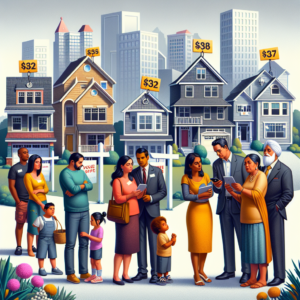
The housing market has long been a barometer of economic health, reflecting the aspirations and challenges of millions of individuals and families. As we navigate through 2023, the landscape of the housing market has undergone significant transformations, revealing trends that are both surprising and informative. This article delves into the latest housing market trends, exploring the factors influencing price fluctuations, the impact of interest rates, regional variations, the role of technology, and future predictions from experts in the field.
Understanding the Current Landscape: An Overview of Housing Market Trends in 2023
In 2023, the housing market is characterized by a complex interplay of factors that have led to both rising and stabilizing prices in various regions. After a period of unprecedented growth during the pandemic, many markets are now experiencing a correction phase. According to recent data, the national median home price has seen a modest decline, while inventory levels remain critically low, creating a competitive environment for buyers. Additionally, the demand for single-family homes continues to be strong, particularly in suburban areas, as remote work remains prevalent. The overall sentiment among potential homebuyers is mixed, with many expressing concerns over affordability and economic uncertainty, which has led to a cautious approach in purchasing decisions.
Key Factors Driving Recent Changes in Housing Prices and Demand Across Major Cities
Several key factors are influencing the recent changes in housing prices and demand across major urban centers. One of the most significant drivers is the ongoing shift in demographics, with millennials and Gen Z increasingly entering the housing market. This younger generation is prioritizing affordability and proximity to amenities, leading to heightened demand in secondary cities and suburban areas. Furthermore, inflationary pressures and rising construction costs have contributed to increased home prices, particularly in metropolitan areas. Additionally, the post-pandemic migration trends have resulted in a redistribution of demand, with many individuals moving away from densely populated cities in search of more space and a better quality of life, further complicating the dynamics of the housing market.
Analyzing the Impact of Interest Rates on Home Buying Behavior and Market Dynamics
Interest rates have a profound impact on home buying behavior and overall market dynamics. In 2023, the Federal Reserve’s decision to raise interest rates in response to inflation has led to higher mortgage rates, which have dampened some of the enthusiasm among potential homebuyers. As borrowing costs increase, many buyers are finding it challenging to afford homes at current price levels, leading to a slowdown in sales activity. This rise in interest rates has also prompted a shift in buyer preferences, with many opting for adjustable-rate mortgages or seeking properties within lower price brackets. Consequently, the market is witnessing a bifurcation, where entry-level homes are still in demand, while luxury properties face longer days on the market.
Regional Variations: How Housing Trends Differ Across Urban and Rural Areas
The housing market in 2023 is not uniform; rather, it exhibits significant regional variations that highlight the contrasting trends between urban and rural areas. Urban centers, particularly those that experienced rapid price increases during the pandemic, are now facing a cooling period as affordability constraints push buyers toward suburban and rural locations. In contrast, many rural areas are witnessing a surge in demand, driven by remote work opportunities and a desire for more spacious living conditions. This shift has led to increased competition and rising prices in previously overlooked markets, as buyers seek to capitalize on the affordability and lifestyle benefits that these areas offer. As a result, the housing market is becoming increasingly decentralized, with emerging hotspots gaining traction.
The Role of Technology in Shaping Modern Real Estate Transactions and Consumer Preferences
Technology continues to play a transformative role in the real estate sector, shaping how transactions are conducted and influencing consumer preferences. In 2023, digital tools such as virtual tours, online listings, and blockchain technology are streamlining the home-buying process, making it more accessible and efficient for buyers and sellers alike. The rise of iBuying platforms has also changed the landscape, allowing homeowners to sell their properties quickly and with minimal hassle. Additionally, data analytics and artificial intelligence are being leveraged to provide insights into market trends and consumer behavior, enabling real estate professionals to make more informed decisions. As technology continues to evolve, it is expected to further enhance transparency and efficiency in the housing market.
Future Predictions: What Experts Anticipate for the Housing Market in the Coming Years
Looking ahead, experts predict that the housing market will continue to evolve in response to economic conditions, demographic shifts, and technological advancements. While some analysts foresee a stabilization of prices as inventory levels gradually increase, others caution that ongoing inflation and interest rate fluctuations may keep the market in a state of uncertainty. Additionally, the demand for sustainable and energy-efficient homes is expected to rise, as consumers become more environmentally conscious. The trend toward remote work is likely to persist, further influencing migration patterns and housing preferences. Overall, the housing market is anticipated to remain dynamic, with opportunities and challenges emerging as new trends take shape.
===
In conclusion, the housing market in 2023 is a complex and multifaceted landscape, shaped by a myriad of factors that influence buyer behavior and pricing dynamics. As we continue to navigate through economic uncertainties and shifting consumer preferences, understanding these trends will be crucial for stakeholders in the real estate sector. Whether you are a potential buyer, seller, or investor, staying informed about the latest developments will be essential in making strategic decisions in this ever-evolving market.




























